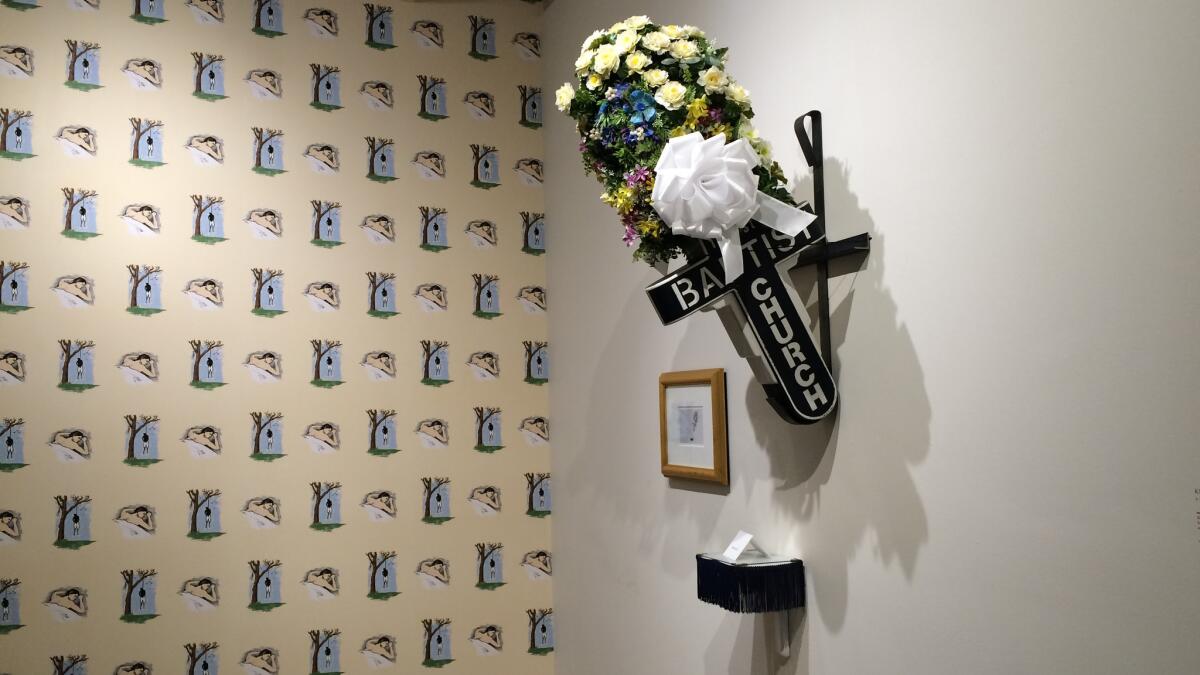Review: Heinous history as potent muse in Underground Museum’s ‘Non-fiction’

The small exhibition “Non-fiction” is an elegiac tone poem, spoken in visual shades of black. With just 10 works by eight artists, it presents no defined thesis but resonates beyond its modest scale.
The work was selected by the late Noah Davis, founder of the Underground Museum in Arlington Heights, where it remains on view until March. The storefront space is collaborating on projects with the Museum of Contemporary Art, which has lent three works from its collection to the show.
The MOCA loans tell a central part of the story.
Marion Palfi’s sensitive, exquisitely shaded 1949 photograph of the “Wife of a Lynching Victim” shows the African American woman, her face simultaneously stunned and wary, seated in what appears to be a bland office. The burst of the camera’s flashbulb is reflected in the window glass above her head, recording a sudden jolt.
The picture seems a cross between a news document and a mug shot. Who’s the victim, who’s the criminal?
The burst of light above the emotionally staggered woman’s head also suggests the sudden dawning of a thought — not for the artist or the sitter, but for the viewer.
Palfi delivers a slow-punch to the gut. Her quietly extraordinary photograph depicts no dramatic violence against the unseen, anonymous African American man who has been murdered. Instead, the picture of his bereft wife and, indirectly, our relationship to the heinous event records other brutalities manifested in the act.
MOCA’s other two loans continue the theme of violence against African Americans, both flagrant and subtle.
One is a five-part etching of antebellum depravity played out in black silhouette figures by Kara Walker, the other a big, bleary, roughly painted Henry Taylor mural (6 feet by 23 feet). The mural, bluntly titled “Warning Shots Not Required” in capital letters stenciled across the upper register, centers on a heavily muscled African American man whose benign presence smacks up against the gruesomely permissive words.
Some well-known works are included, such as Robert Gober’s pale yellow wallpaper for a youngster’s bedroom, its pattern alternating images of a peacefully sleeping white man with a lynched black man; and, Kerry James Marshall’s elegy to the murderous 1963 church bombing in Birmingham, Ala., his hometown, when he was 7.
Marshall, primarily a painter, here presents a wall-ensemble that joins an elaborate, flower-bedecked cross with a framed video still of the wall-ensemble itself. A notecard placed atop a tiny altar below mockingly declares, “As Seen on TV.” The physical object and its ephemeral image establish an endless loop of suffering at the hands of white supremacy.
Deana Lawson, a younger New York artist, has photographed a naked couple seated side by side in the verdant jungle of an equatorial town in the Democratic Republic of the Congo. The man turns his head and rests his hand on the woman’s belly, repeating a tender fertility pose familiar from traditional African sculpture — itself hugely influential in the formal development of Modern art in the West.
Lawson pictures a latter-day Adam and Eve whose deep, dark, luxurious black skin resonates with the ancestral, prehistoric origins of global humanity. Nearby, Theaster Gates’ bulky black box affixed to a wall is built from layers of roofing paper, rubber, metal and tar over wood, establishing a metaphor for a social construction of blackness assembled from domestic materials.
Titled “Sheol,” the darkness of the underworld told in the Hebrew Bible is reframed using the Modern abstract motif of a traditional black-painting. Sheol is a place where all souls convene after death, whether they are righteous or wicked. That mordant theme is sent spinning by “In the Hood (Gray),” a marvelous new sculpture by David Hammons.
Hammons, 72, is among the greatest living American artists, and the brilliant economy of means with which he layers meaning is in full evidence here.
Inside a tall, shallow, narrow little room painted bright white, Hammons has suspended a hood from invisible monofilament. The floating hood overhead has been crudely scissored from an ordinary gray athletic sweatshirt. It’s a talisman whose form and color evoke awful outcomes spanning the deaths of Trayvon Martin in 2012 and Freddie Gray last year.
The sporty hood is like the humble cowl worn by a penitent monk crossed with the inescapable echo of the modern hoods worn by the craven Ku Klux Klan. It hovers in a luminous space that merges a chapel with a closet — a place of sanctity and one of fear. The sculpture is emblematic of the exhibition’s “Non-fiction” title, which draws a bright line beneath this art’s powerful, personal testimony.
------------
The Underground Museum, 3508 W. Washington Blvd., Los Angeles, (323) 989-9925, through March. Closed Mondays and Tuesdays. www.theunderground-museum.org
Follow me @KnightLAT
More to Read
The biggest entertainment stories
Get our big stories about Hollywood, film, television, music, arts, culture and more right in your inbox as soon as they publish.
You may occasionally receive promotional content from the Los Angeles Times.











